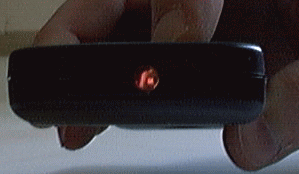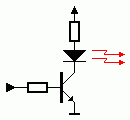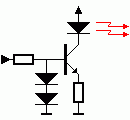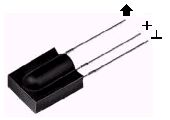
| Navigation |
Home
Knowledge
Base
IR RC Theory
ITT
Protocol
NEC
Protocol
Nokia
NRC17
Sharp
Protocol
Philips
RC-5
Other
Protocols
| IR Remote Control Theory |
The cheapest way to remotely control a device within a visible range is
via Infra-Red light. Almost all audio and video equipment can be
controlled this way nowadays. Due to this wide spread use the required
components are quite cheap. Thus making it ideal for us hobbyists to use
for our own projects.
This part of my knowledge base will explain the
theory of operation of IR remote control, and some of the protocols that
are in use in consumer electronics.
| Infra-Red Light |
Infra-Red actually is normal light with a particular colour. Us humans can't see this colour because it's wave length of 950nm is below the visible spectrum. That's one of the reasons why IR is chosen for remote control purposes, we want to use it but we're not interested in seeing it. Another reason is because IR LEDs are quite easy to make, and therefor can be very cheap.
 Although we humans can't see the Infra-Red
light emitted from a remote control doesn't mean we can't make it visible.
Although we humans can't see the Infra-Red
light emitted from a remote control doesn't mean we can't make it visible.
A video camera or digital camera can "see" the Infra-Red light as you
can see in this picture.
Unfortunately for us there are many more sources of Infra-Red light.
The sun is the brightest source of all, but there are many others, like:
light bulbs, candles, central heating system, and even our body radiates
Infra-Red light. In fact everything that radiates heat, also radiates
Infra-Red light.
Therefor we have to take some precautions
to guarantee that our IR message gets across to the receiver without
errors.
| Modulation |
Modulation is the answer to make our signal stand out above the noise.
With modulation we make the IR light source blink in a particular
frequency. The IR receiver will be tuned to that frequency, so it can
ignore everything else.
You can think of this blinking as attracting
the receiver's attention. We humans also notice the blinking of yellow
lights at construction sites instantly, even in brought daylight. 
In the picture above you can see a modulated signal driving
the IR LED of the transmitter on the left side. The detected signal is
coming out of the receiver at the other side.
In serial communication we usually speak of 'marks' and 'spaces'. The
'space' is the default signal, which is the off state in the transmitter
case. No light is emitted during the 'space' state. During the 'mark'
state of the signal the IR light is pulsed on and off at a particular
frequency. Frequencies between 30kHz and 60kHz are commonly used in
consumer electronics.
At the receiver side a 'space' is represented by
a high level of the receiver's output. A 'mark' is then automatically
represented by a low level.
Please note that the 'marks' and 'spaces' are not the 1-s and 0-s we want to transmit. The real relationship between the 'marks' and 'spaces' and the 1-s and 0-s depends on the protocol that's being used. More information about that can be found on the pages that describe the protocols.
| The Transmitter |
The transmitter usually is a battery powered handset. It should consume as little power as possible, and the IR signal should also be as strong as possible to achieve an acceptable control distance. Preferably it should be shock proof as well.
Many chips are designed to be used as IR transmitters. The older chips were dedicated to only one of the many protocols that were invented. Nowadays very low power microcontrollers are used in IR transmitters for the simple reason that they are more flexible in their use. When no button is pressed they are in a very low power sleep mode, in which hardly any current is consumed. The processor wakes up to transmit the appropriate IR command only when a key is pressed.
Quartz crystals are seldom used in such handsets. They are very fragile and tend to break easily when the handset is dropped. Ceramic resonators are much more suitable here, because they can withstand larger physical shocks. The fact that they are a little less accurate is not important.
The current through the LED (or LEDs) can vary from 100mA to well over 1A! In order to get an acceptable control distance the LED currents have to be as high as possible. A trade-off should be made between LED parameters, battery lifetime and maximum control distance. LED currents can be that high because the pulses driving the LEDs are very short. Average power dissipation of the LED should not exceed the maximum value though. You should also see to it that the maximum peek current for the LED is not exceeded. All these parameters can be found in the LED's data sheet.
 A simple transistor circuit can be used to drive the
LED. A transistor with a suitable HFE and switching speed should be
selected for this purpose.
A simple transistor circuit can be used to drive the
LED. A transistor with a suitable HFE and switching speed should be
selected for this purpose.
The resistor values can simply be
calculated using Ohm's law. Remember that the nominal voltage drop over an
IR LED is approximately 1.1V.
 The normal driver, described above, has one
disadvantage. As the battery voltage drops, the current through the LED
will decrease as well. This will result in a shorter control distance that
can be covered.
The normal driver, described above, has one
disadvantage. As the battery voltage drops, the current through the LED
will decrease as well. This will result in a shorter control distance that
can be covered.
An emitter follower circuit can avoid this. The 2
diodes in series will limit the pulses on the base of the transistor to
1.2V. The base-emitter voltage of the transistor subtracts 0.6V from that,
resulting in a constant amplitude of 0.6V at the emitter. This constant
amplitude across a constant resistor results in current pulses of a
constant magnitude. Calculating the current through the LED is simply
applying Ohm's law again.
| The Receiver |
Many different receiver circuits exist on the market. The most important selection criteria are the modulation frequency used and the availability in you regeon.

In the picture above you can see a typical block
diagram of such an IR receiver. Don't be alarmed if you don't understand
this part of the description, for everything is built into one single
electronic component.
The received IR signal is picked up by the IR
detection diode on the left side of the diagram. This signal is amplified
and limited by the first 2 stages. The limitter acts as an AGC circuit to
get a constant pulse level, regardless of the distance to the handset.
As you can see only the AC signal is sent to the Band Pass Filter. The
Band Pass Filter is tuned to the modulation frequency of the handset unit.
Common frequencies range from 30kHz to 60kHz in consumer electronics.
The next stages are a detector, integrator and comparator. The purpose
of these three blocks is to detect the presence of the modulation
frequency. If this modulation frequency is present the output of the
comparator will be low.
 As I said before, all these blocks are integrated into a single
electronic component. There are many different manufacturers of these
components on the market. And most devices are available in several
versions each of which are tuned to a particular modulation frequency.
As I said before, all these blocks are integrated into a single
electronic component. There are many different manufacturers of these
components on the market. And most devices are available in several
versions each of which are tuned to a particular modulation frequency.
Please note that the amplifier is set to a very high gain. Therefor the system tends to start oscillating very easily. Placing a large capacitor of at least 22µF close to the receiver's power connections is mandatory to decouple the power lines. Some data sheets recommend a resistor of 330 Ohms in series with the power supply to further decouple the power supply from the rest of the circuit.
There are several manufacturers of IR receivers on the market. Siemens
and Telefunken are the main suppliers here in Europe. Siemens has it's
SFH506-xx series, where xx denotes the modulation frequency of 30, 33, 36,
38, 40 or 56kHz. Telefunken has it's TFMS5xx0 and TK18xx series, where xx
again indicates the modulation frequency the device is tuned to.
Sharp, Xiamen Hualian and Japanese Electric are 3 Asian IR receiver
producing companies. Sharp has devices with very cryptic ID names, like:
GP1UD26xK, GP1UD27xK and GP1UD28xK, where x is related to the modulation
frequency. Hualian has it's HRMxx00 series, like the HRM3700 and HRM3800.
Japanese Electric has a series of devices that don't include the
modulation frequency in the part's ID. The PIC-12042LM is tuned to
36.7kHz, and the PIC12043LM is tuned to 37.9kHz.
| The End? |
This concludes the theory of operation for IR remote control systems intended for use in consumer electronics. I realise that other ways exist to implement IR control, but I will limit myself to the description above. One of the issues not covered here is security. Security is of no importance if I want to control my VCR or TV set. But when it comes to opening doors or cars it literally becomes a 'key' feature! Maybe I will cover this issue later, but not for now.
I also realise that my small list of manufacturers is far from being complete. It is hardly possible to list every manufacturer here.
This page only described the basic theory of operation of IR remote control. It did not describe the protocols that are involved in communication between transmitter and receiver. Many protocols are designed by different manufacturers. You can find the protocols of some manufacturers in the link section at the top of this page.
http://www.sbprojects.com/